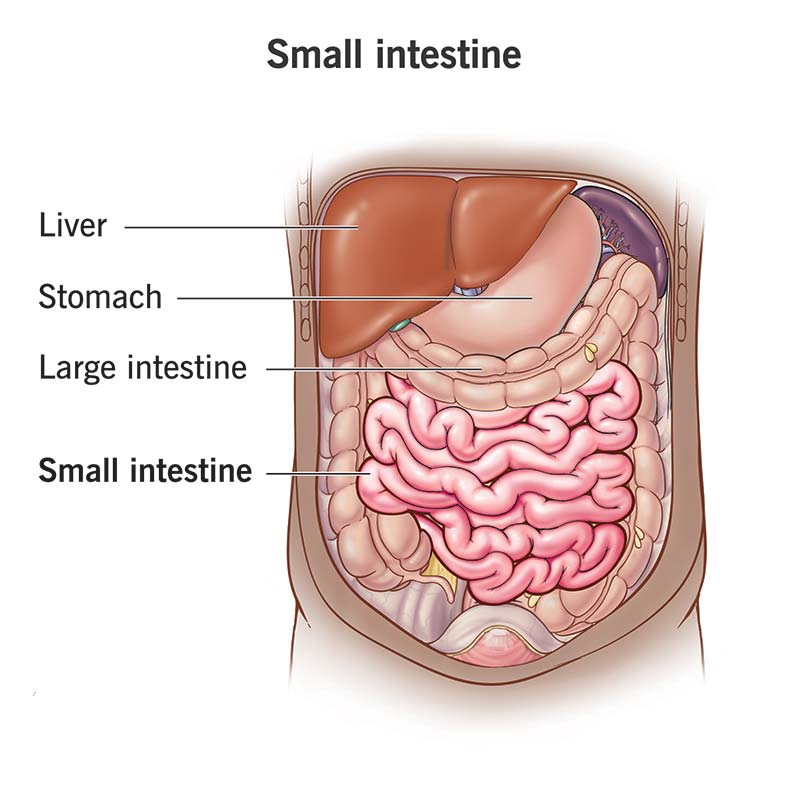MCQ ON SMALL INTESTINE/ SMALL INTESTINE class 11 for NEET | SMALL INTESTINE class 11| MCQ SMALL INTESTINE with Answer | Check the below NCERT MCQ question for class 11Biology based on the with Answers.
MCQ on SMALL INTESTINE class 11Biology with answers were prepared based on the latest pattern. We have provided class 11 Biology MCQs question with Answers to help students understand the concept very well.

MCQ ON SMALL INTESTINE/ SMALL INTESTINE class 11 for NEET
MCQ ON SMALL INTESTINE is useful for NEET / CSIR / UGC / CBSE / ICSE / AIIMS / EXAM / AFMC EXAM / STATE LEVEL MEDICAL EXAM/ KVS PGT BIOLOGY / NVS PGT BIOLOGY EXAM 2023-2024 ,2025
INTRODUCTION:-
SMALL INTESTINE:-
The small intestine is distinguisible into three regions a C shaped duodenum a long coiled middle portion jejunum and highly coiled ileum . Dopening of stomach into duodenum is guarded by pyloric sphincter ,
Ileum opens into large intestine.
In duodenum glands are also present in submucosa .
The innermost layer lining the lumen of the elementary canal is the mucosa .
This layer forms irregular force in the stomach and small finger like folding called villi in the small intestine.
The cells lining the villi produces numerous microscopic projection called microvilli giving a brush border appearance.
These modification increase surface area enormously. Villi are supplied with a network of capillaries and a large lymph vessel called lacteals.
STOMACH:-
The stomach located in the upper left portion of the abdominal cavity has four major parts a cardiac portion into which the oesophagus opens
, fundic region which small dome like upper part that projects above the cardiac aperture , it oftens contain gas or air.
A pyloric portion which opened into the first part of a small intestine, it is a right narrow lower portion of the stomach, it comprises a wider pyloric antrum and narrow pyloric canal,
Body:- it is a main middle region of the stomach
In a surface of a stomach has numerous folds the gastric rugae . These folds by unfolding let the stomach expands to accommodate large meal about 2 l of food and water
Different foods remain in the stomach for different durations carbohydrate for only one or two hours, protein for up to 3 hours and fats for 3 to 6 hours .
Thus a fat rich food should be taken if the next meal is expected to be available after long time.
An athletes should take carbohydrate rich diet before competition.
When the stomach is empty its contraction stop and a period of rest begins. After a few hours contraction restart causing the feeling of hunger.
Ruminants have a large compound stomach.
These are mammals that chewed the cud.
The stomach of cattle buffaloes goats sheep mammals consists of four chambers – rumen , reticulum , omasum , abomasum.
The stomach of camels and dear lacks omasum.
Rumen is the largest chamber and receives oesophagus. In this chamber food undergoes mechanical and chemical breakdown.
MCQ ON SMALL INTESTINE class 11 for NEET/KVS PGT BIOLOGY / NVS PGT BIOLOGY EXAM 2023-2024,2025
1. The small intestine is a narrow tube about long in living adult
(a) 5 metres
(b) 6 metres
(c) 7 metres
(d) none of the above
Ans (b) 6 metres
2. The longest part of the alimentary canal is
(a) stomach
(b) small intestine
(c) large intestine
(d) liver
Ans. (b) small intestine
3. Small intestine comprises how many parts
(a) 3
(b) 2
(c) 4
(d) all the above
Ans. (a) 3
4. Small intestine comprises three parts are
(a) duodenum
(b) jejunum
(c) ileum
(d) all the above
Ans.(d) all the above
5. The shape of duodenum is
(a) U shaped
(b) C shaped
(c) B shaped
(d) J shaped
Ans.(b) C shaped
6. Which follows the stomach?
(a) jejunum
(b) duodenum
(c) ileum
(d) none of the above
Ans.(b) duodenum
7. The middle part of a small intestine is
(a) ileum
(b) jejunum
(c) duodenum
(d) all the above
Ans.(b) jejunum
8. The lowest part of the small intestine is
(a) duodenum
(b) ileum
(c) jejunum
(d) all the above
Ans.(b) ileum
9. The inner surface of small intestine is thrown into a series of permanent circular folds called
(a) plicae circulars
(b) villi
(c) microvilli
(d) all the above
Ans. (a) plicae circulars
10. The mucosa is raised into numerous microscopic projection called
(a) microvilli
(b) villi
(c) rugae
(d) all the above
Ans. (b) villi
11. Small white patches of lymphoid tissue called
(a) payer’s patches
(b) bile
(c) bilirubin
(d) all the above
Ans.(a) payer’s patches
12. Peter’s patches fights
a) for food
b) for digestion
c) against infection
(d) all the above
Ans . (c) against infection
13. The small intestine serve the main functions
(a) completion of digestion
(b) absorption of digested food
(c) both a and b
(d) none of the above
Ans.(c) both a and b
14. the hormone secreted by small intestine is
(a) duocrinin
(b) enterocrinin
(c) enterogasterone
(d) all the above
Ans. (d) all the above
ALSO READ:-
● YOU CAN WATCH BIOLOGY SIR Youtube channel
15. Peyer’s patches occur on the
(a) mucous membranes of the small intestine
(b) jejunum
(c) ileum
(d) all the above
Ans.(a) mucus membrane of small intestine
16.Hepatopancreatic duct formed by
(a) union of bile duct and pancreatic duct
(b) Pancreatic duct only
(c) bile duct only
(d) none of the above
Ans.(a) union of bile duct and pancreatic duct.







Leave a Comment